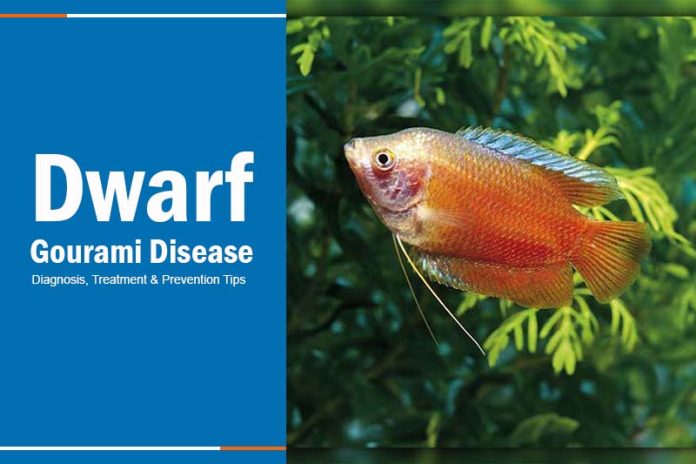Are you concerned about the health of your dwarf gourami? Have you noticed unusual symptoms like inflamed gills, lesions, or changes in behavior? If you’re nodding your head, you’re likely facing the perplexing issue of dwarf gourami disease.
This blog post is designed to be your comprehensive guide to understanding, diagnosing, and managing dwarf gourami disease. We’ll delve into the symptoms, potential treatments, and preventative measures to ensure your aquatic pets live healthier, happier lives. Keep reading to become an informed dwarf gourami owner.
4 popular Dwarf Gourami Diseases you should know
 Taking care of a dwarf gourami can be a rewarding experience, but it also comes with responsibilities, including understanding potential health issues. Knowing about these conditions early on can be vital for the well-being of your finned friend. Here are four common diseases that dwarf gouramis are susceptible to, along with their symptoms and treatment options.
Taking care of a dwarf gourami can be a rewarding experience, but it also comes with responsibilities, including understanding potential health issues. Knowing about these conditions early on can be vital for the well-being of your finned friend. Here are four common diseases that dwarf gouramis are susceptible to, along with their symptoms and treatment options.
Fin Rot
Fin rot is more than just a cosmetic issue; it’s a bacterial infection that could lead to severe health problems if not addressed promptly. Signs to watch out for include a diminishing appetite and a whitish discoloration on the fins that gradually moves towards the base.
Ichthys
Commonly known as “Ich,” this disease manifests as tiny white spots or pimples on the fins, making the fish appear unclean or even lethargic. These spots are cysts filled with protozoan parasites.
To treat Ich, consider raising your tank’s water temperature gradually until it reaches about 90 degrees Fahrenheit (32 degrees Celsius). Then add one teaspoon of aquarium salt for disinfection. These steps help to rupture the cysts, making medication more effective.
DGIV
This viral infection can be quite devastating, and currently, there is no known cure. DGIV often results in symptoms such as loss of appetite, lethargy, and swelling around the eyes and body, eventually leading to death. If you notice these signs, it’s crucial to isolate the affected fish to prevent the spread of the virus.
New Tank Syndrome
Newcomers to the fish-keeping hobby might encounter what’s known as New Tank Syndrome. This issue arises from ammonia toxicity in an uncycled tank, which can be very harmful to dwarf gouramis.
The Truth About Dwarf Gourami Disease – DGD, DGIV, Diagnosis & More
Dwarf Gourami Disease: Prevents

Regularly cleaning your tank, at least once a week, helps to eliminate waste and other contaminants. Don’t overlook the removal of deceased fish, as they can quickly become a breeding ground for bacteria and parasites.
Monitoring your tank’s water conditions is crucial. Make it a habit to test the pH, ammonia, nitrite levels, and temperature of the water. Imbalances in any of these factors can lead to stressful conditions, making your dwarf gourami more susceptible to diseases.
If you notice any symptoms of illness in your fish or have recently lost a fish to disease, consider conducting daily water changes. Replacing a portion of the tank water can help dilute any harmful substances and assist in the recovery of your fish.
Overfeeding or irregular feeding can result in excess food decay, affecting the water quality and increasing the risk of diseases.
Symptoms of Iridovirus Dwarf Gourami Disease
One of the initial signs may include erratic or hyperactive swimming patterns. This change in behavior can be unsettling and is usually a red flag that something isn’t right with your fish’s health.
Affected dwarf gouramis often exhibit a lack of appetite or irregular eating habits. Though a change in eating behavior can be attributed to various factors, combined with other symptoms, it could be indicative of DGIV.
Noticeable swelling in the belly area is another symptom that should raise concern. This swelling can be both visible and palpable, and it indicates internal issues that require attention.
Appearance of red spots or blotches on the skin is a significant symptom. These spots can vary in size and shape but are generally a clear sign of an underlying health issue like DGIV.
A vibrant color is one of the hallmarks of a healthy dwarf gourami. If you notice that your fish’s color is becoming dull or is diminishing, it might be a symptom of this iridovirus.
Learn more: Dwarf Gourami Care: Essential Tips for a Thriving Aquarium
Iridovirus Dwarf Gourami Disease: Treatment
It’s disheartening to acknowledge that, as of now, there’s no cure for Dwarf Gourami Iridovirus. The absence of a definitive treatment makes this viral condition particularly challenging to manage.
If you suspect that your dwarf gourami is affected by DGIV, the immediate step to take is isolation. By separating the sick fish from the rest of the tank inhabitants, you can prevent the virus from spreading,
providing a comfortable environment for the isolated fish. But if your fish is severely suffering and there’s no hope for recovery, you might consider euthanasia as a humane option.
However, before making any irreversible decisions, it’s crucial to consult with a veterinary professional to confirm the presence of the iridovirus.
What Causes Dwarf Gourami swim Bladder Disease occur?
Swim bladder disease is a condition that affects a fish’s buoyancy, causing it to float uncontrollably, swim sideways, or even sink to the bottom of the tank.
One of the primary culprits is suboptimal water quality. High levels of ammonia, nitrites, and fluctuating pH can stress your fish, making them more susceptible to swim bladder issues.
Improper feeding can directly affect the swim bladder. Overfeeding or feeding food that is difficult to digest can lead to constipation, affecting the function of the swim bladder.
Sudden changes in water temperature can stress your fish and lead to swim bladder disease.
Bacterial or parasitic infections can also contribute to swim bladder problems.
Some fish might be genetically more prone to developing swim bladder disease than others.
Dwarf Gourami Disease contagious other Fish?

DGIV is, indeed, a highly contagious virus. While dwarf gouramis are the primary targets of this virus, it’s important to note that other types of gouramis are also susceptible. If you keep multiple species of gouramis in the same aquarium, you should be particularly vigilant about monitoring their health.
Although instances have been reported where other species of freshwater fish were infected, these cases are relatively rare when compared to gouramis. That said, the risk is not zero, and it’s advisable to keep a watchful eye on all tank inhabitants if you suspect DGIV is present.
What is Dwarf Gourami Disease?
Dwarf Gourami Disease (DGD) is a bacterial infection that primarily targets the gills and skin of dwarf gouramis. It’s a condition that manifests through a variety of troubling symptoms, including inflammation, lesions, and other visible signs of distress on your fish. Although it is not always a fatal condition, it can certainly lead to severe complications and even death if left untreated.
It’s important to note that while there’s no definitive cure for DGD, various treatment options can alleviate symptoms and help prevent the disease from spreading further within your aquarium. This usually involves medications targeted at bacterial infections and may also include steps like isolating the affected fish
My Experience Keeping for Dwarf Gourami
Conclusion
In conclusion, understanding dwarf gourami disease is vital for any responsible fish owner. From recognizing the early signs to taking the necessary preventive measures, being well-informed can make all the difference in the health and well-being of your dwarf gouramis.
If you found this blog helpful, we encourage you to explore more informative and engaging articles from Kalonaquatics. We’re dedicated to helping you make the most of your fishkeeping experience. Keep swimming through our content to stay updated on the latest in aquatic care and advice!
Check out:
- Why is My Gourami Hiding and How to Comfort Them?
- Why Is My Gourami Laying on the Bottom of the Tank?
- Why Is My Gourami Laying on Its Side? Quick Help!
- The Dark Side of Aquarium: Why is my Honey Gourami Turning Black?

Growing up in a coastal town, surrounded by the soothing sounds of ocean waves, I have developed an early fascination with marine life. This fascination eventually led me to a career as an aquatic biologist and a passion for sharing my knowledge with the world. With years of experience, I’m here to help you create vibrant and sustainable underwater ecosystems. Swim along with me on this fin-tastic journey!

